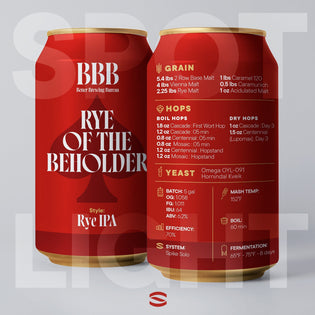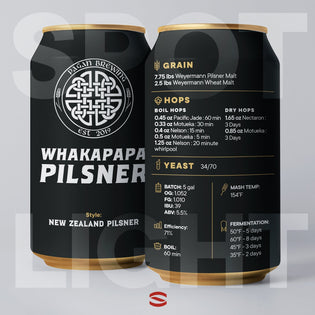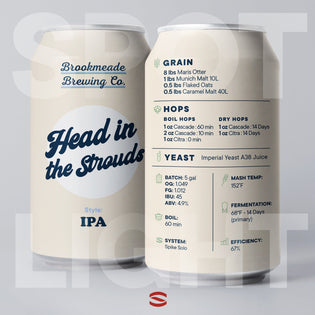
The Brewers: Mike, Geoff and Mike
When it comes to home brewing, these three guys know what’s up. Based in Eden, New York, Mike E., Geoff H. and Mike K. founded the home brew club, Crooked Lamp Post Brew Club. They love to consistently challenge themselves through food pairings, inter-club competitions, recipe challenges, off-flavor tasting competitions and other various forms of “beer research."

“Our name came after Geoff backed over a lamp post in my front yard during a snowstorm. I had no idea it happened and woke up the next morning, sans lamp post. It was buried under two feet of snow,” chuckles Mike E. The three brewers live in the same neighborhood—which is ideal since the brewery is in Mike E.’s garage.

Since starting their brew club in 2014, their equipment has evolved from a home brew extract kit to a 20-gallon Spike Trio System with two glycol cooled CF10’s. “The Trio offers loads of flexibility so that you can adapt your brewing process and repeat recipes with great consistency,” Mike E. says. “This may sound cheesy, but working on the Trio makes me feel like a real brewer,” laughs Mike K. “I’m still getting comfortable with the system, but it sure beats brewing on a stove top!”
“If you’re just starting out, my advice would be to not get overwhelmed,” notes Geoff. “It's a continual process of learning and trying different techniques and recipes. No one starts off knowing everything—at least not in our home brew club!”
The Beer: Hazy Pale Ale
The name Crookenhop is a combo of Crooked Lamp Post Brew Club, the YouTube show they were brewing it for (In Hops We Trust) and the brewery they collaborated with, Hackensack Brewery. “Crookenhop is a deliciously smooth, sessionable pale ale coming in at 4.5%,” Mike E. says.

“This beer is all about restraint. The ingredients work well with each other to create a low alcohol, smooth, tropical pale ale. It’s basically a tropical summer crusher that’s super easy to drink.”

“We added Melba hops only to the dry hop as they can impart more bitterness than we desired for this low alcohol, hazy tropical summer crusher.”
The Recipe: Crookenhop

INGREDIENTS
GRAIN
- 18 lbs Row Base Malt
- 3 lbs German Pale Wheat Malt
HOPS
- Boil hops: 0.5 oz Gr Magnum - 1st Wort
- Boil hops: 2 oz Cashmere - 0:00 min
- Boil hops: 2 oz Huell Melon - 0:00 min
- Boil hops: 2 oz Cashmere - 175ºF for 15 min
- Boil hops: 2 oz Huell Melon - 175ºF for 15 min
- Dry hops: 4 oz Melba - 3 days
- Dry hops: 2 oz Cashmere - 3 days
- Dry hops: 2 oz Huell Melon - 3 days
YEAST
- 4 Pckgs of Wyeast 1318

INSTRUCTIONS
BATCH SIZE: 10 gal
OG: 1.046
FG: 1.012
IBU: 10
ABV: 4.5%
EFFICIENCY: 75%
MASH TEMP: 153ºF
BOIL: 60 min
FERMENTATION: 68ºF - 7 days
SYSTEM: Trio
Pro Tips
- When it comes to the grain bill, take the “less is more” approach with this beer and you will be happy. Adding too many grains will “muddy” the waters and take away from the hop character. Two-row base malt is neutral but with enough sweetness to let the hops play the leading role. About 15% of the grain bill is pale wheat malt which helps add a smooth mouthfeel due to its high protein content.
- Wyeast 1318 is used to complement the hop flavors. 1318 works great with dry hopping and will finish with a gravity (1.012-1.020) that does not dry this beer out too much. Because of this yeast’s characteristics, you will be left with a perfect balance of sweetness and fruit flavors that blend beautifully with the hops.
Cheers,
Mike, Geoff and Mike - Crooked Lamp Post Brewery
Spike Summarizes: All About Hazy Pale Ales
What is a Hazy Pale Ale?
A Hazy Pale Ale, also known as a New England Pale Ale or Juicy Pale Ale, is a beer style that combines the hop-forward characteristics of a Pale Ale with the hazy and juicy qualities of a New England IPA.
They bridge the gap between Pale Ales and New England IPAs, offering a more approachable version of the hazy and juicy beer trend. They retain the hop flavors and aromas of a Pale Ale while exhibiting a hazy appearance and a softer mouthfeel.
Hazy Appearance
One of the defining features of Hazy Pale Ales is their cloudy or hazy appearance. This comes from the use of specific brewing techniques and the presence of proteins, hop compounds, and suspended yeast in the beer.
What distinguishes Hazy Pale Ale from other beers?
Hazy Pale Ales have unique characteristics that set them apart from other beer styles, including traditional Pale Ales and New England IPAs.
Appearance and Texture
Unlike traditional Pale Ales, which are usually clear, Hazy Pale Ales have a cloudy appearance, similar to New England IPAs. The haziness comes from the use of certain grains, such as wheat or oats, and a brewing technique that promotes the suspension of particulate matter in the beer. Additionally, Hazy Pale Ales often exhibit a smooth and creamy mouthfeel.
Flavor Profile
Hazy Pale Ales offer a complex and hop-forward flavor profile. They showcase fruity and tropical hop flavors, often with notes of citrus, stone fruit, and melon. The hop bitterness is usually moderate, allowing the hop flavors and aromas to take center stage. Hazy Pale Ales also tend to have a slightly sweeter malt backbone, balancing the hop character.
Aromatic Intensity
Hazy Pale Ales are known for their intense hop aroma. They exhibit bright and vibrant aromas of hops, with a focus on tropical and citrus fruits. The aromatic bouquet of these beers can be enticing and inviting.
What's the history of Hazy Pale Ale?
Hazy Pale Ales emerged as a response to the rising popularity of New England IPAs, which showcased hazy appearances and intense hop flavors. Brewers sought to create a more accessible version of these beers, resulting in the birth of Hazy Pale Ales.
Hazy Pale Ales draw inspiration from the brewing techniques and flavor profiles of New England IPAs. The haziness, juicy hop character, and emphasis on hop aroma were elements that brewers wanted to incorporate into a more sessionable beer.
Brewers experimented with different grain bills, yeast strains, and hopping techniques to achieve the desired hazy appearance and juicy flavors while keeping the alcohol content lower than that of IPAs. This experimentation led to the development of the Hazy Pale Ale style.
What does a Hazy Pale Ale taste like?
Hazy Pale Ales offer a flavorful and aromatic experience that combines hop-forward characteristics with a smooth and approachable profile.
Hop Flavor and Aroma
Hazy Pale Ales showcase a wide range of hop flavors and aromas. Tropical fruits like mango, pineapple, and passionfruit are commonly present, along with citrus notes such as grapefruit and orange. Some Hazy Pale Ales may also exhibit hints of stone fruit or melon.
Balanced Bitterness
While hop bitterness is still present in Hazy Pale Ales, it is typically moderate compared to traditional Pale Ales. The focus is more on hop flavor and aroma rather than intense bitterness, resulting in a smoother and more approachable drinking experience.
Malt Backbone
Hazy Pale Ales have a slightly sweeter malt backbone compared to some other hop-forward beer styles. The malt provides a subtle sweetness that balances the hop flavors and adds depth to the overall flavor profile.
How is Hazy Pale Ale made?
The brewing process for Hazy Pale Ales involves specific techniques to achieve the desired hazy appearance, intense hop flavors, and balanced profile.
Grain Bill
Hazy Pale Ales typically include a combination of pale malt, wheat, and/or oats. These grains contribute to the beer's haziness and smooth mouthfeel. The use of high-protein grains like wheat and oats helps create the desired suspended haze.
Hop Selection
A variety of hops can be used in Hazy Pale Ales, depending on the brewer's preference. Hops with tropical, citrus, and stone fruit characteristics are common choices to enhance the juicy and aromatic qualities of the beer.
Hopping Techniques
Hazy Pale Ales often employ multiple hop additions during the brewing process. Early additions provide bitterness, while late additions and dry hopping contribute to intense hop flavors and aromas. Some brewers use techniques like hop bursting or hop stands to maximize the hop character.
Yeast Strains
Yeast strains used in Hazy Pale Ales are often chosen for their ability to produce fruity esters that complement the hop flavors. Certain yeast strains may also contribute to the hazy appearance of the beer by keeping more suspended particles in suspension.
Water Chemistry
Water chemistry plays a significant role in brewing Hazy Pale Ales. Adjustments can be made to the water profile to enhance hop flavors and promote haze formation. Some brewers aim for a balanced profile, while others may focus on softer water with a higher chloride to sulfate ratio to accentuate the malt sweetness and mouthfeel.
What foods go best with a Hazy Pale Ale?
Hazy Pale Ales pair well with a variety of foods, thanks to their hop-forward and flavorful nature. Here are some food pairing ideas to enhance your Hazy Pale Ale experience:
Spicy Foods
The fruity and tropical hop flavors in Hazy Pale Ales complement the heat and spice of dishes like Thai curries, tacos, or buffalo wings. The hops can provide a refreshing contrast to the spice, while the beer's smooth mouthfeel helps cool the palate.
Grilled Meats and Seafood
Hazy Pale Ales work harmoniously with grilled meats and seafood. The beer's hop flavors and moderate bitterness complement the charred and smoky flavors of grilled steaks, burgers, chicken, or grilled fish. It also pairs well with grilled vegetables, adding a refreshing and hoppy dimension to the dish.
Cheese and Charcuterie
The fruity and aromatic qualities of Hazy Pale Ales make them an excellent accompaniment to cheese and charcuterie boards. The beer's hop flavors can balance the richness of cheeses like cheddar, gouda, or brie, while the carbonation helps cleanse the palate between bites.
Light Salads and Fresh Appetizers
Hazy Pale Ales' vibrant hop character pairs well with light and fresh dishes like salads, bruschetta, or ceviche. The beer's tropical and citrus notes complement the bright flavors of herbs, citrus dressings, and fresh vegetables, providing a refreshing and flavorful combination.
Is Hazy Pale Ale a year-round beer?
Hazy Pale Ales are highly versatile and can be enjoyed year-round, depending on personal preferences and regional availability.
The juicy and tropical hop flavors of Hazy Pale Ales make them especially enjoyable during warmer seasons. The beer's refreshing profile and vibrant aromas can be a perfect complement to summer activities, outdoor gatherings, and barbecues.
While often associated with warm weather, Hazy Pale Ales can still be enjoyed during colder months. Their flavor complexity and smooth mouthfeel make them a satisfying choice for indoor gatherings or alongside comfort foods.
Overall Versatility
Hazy Pale Ales' balanced and approachable profile allows them to be appreciated throughout the year, adapting to various occasions and personal preferences. Whether it's a refreshing summer sipper or a flavorful winter treat, Hazy Pale Ales offer year-round enjoyment.
How strong is a typical Hazy Pale Ale?
Hazy Pale Ales generally have a moderate alcohol by volume (ABV) ranging from 4% to 6%.
The moderate alcohol content of Hazy Pale Ales makes them highly sessionable, meaning you can enjoy multiple servings without becoming overwhelmed by their potency. This makes them a great choice for longer social gatherings or when you want to savor the flavors of the beer over an extended period.
Flavor Focus
Hazy Pale Ales prioritize flavor complexity and hop character rather than high alcohol content. The moderate ABV allows the hop flavors and aromas to shine without overpowering the overall drinking experience.
Are there different types of Hazy Pale Ale beers?
Within the Hazy Pale Ale category, there can be variations in hop profiles, malt bills, and brewing techniques, resulting in different sub-styles or interpretations of the style.
Hop Varieties
Different hop varieties can be used to create variations within the Hazy Pale Ale style. Brewers may choose hops that showcase specific flavors and aromas, such as tropical fruits, citrus, or stone fruits. This selection can result in subtle differences in flavor and aroma profiles.
Malt Bill
The choice of grains in the malt bill can also influence the character of Hazy Pale Ales. While pale malt is a common base, variations may include the use of additional specialty malts, such as wheat or oats, to enhance the mouthfeel and haze
Brewing Techniques
Brewing techniques can vary among breweries, resulting in different interpretations of Hazy Pale Ales. Some brewers may focus on maximizing hop flavor and aroma through specific hopping schedules, while others may experiment with different yeast strains or water profiles to create unique variations of the style.
These variations contribute to the diversity within the Hazy Pale Ale category, allowing beer enthusiasts to explore different flavor profiles and find their preferred expressions of the style.
What's the correct temperature for serving Hazy Pale Ale?
The recommended serving temperature for Hazy Pale Ales is typically between 45°F (7°C) and 50°F (10°C). Hazy Pale Ales should be served slightly cooler than traditional Pale Ales or lagers to enhance the aroma and flavor experience. This temperature range allows the hop aromas to be more pronounced while maintaining the beer's refreshing qualities.
Chilled Glassware
To maintain the desired temperature, it is recommended to chill the glassware before pouring the Hazy Pale Ale. This helps keep the beer at an optimal serving temperature for a longer duration, allowing you to fully appreciate its aromas and flavors.
Why does Hazy Pale Ale have a hazy appearance?
The hazy appearance of Hazy Pale Ales is a result of specific brewing techniques and the presence of proteins, hop compounds, and suspended yeast in the beer.
Brewing Techniques
Brewers intentionally employ techniques to promote haze formation in Hazy Pale Ales. These techniques can include the use of high-protein grains like wheat or oats, extended whirlpooling, dry hopping during or after fermentation, and reducing filtration or fining processes. These methods help keep more suspended particles in the beer, resulting in the desired haze.
Protein and Hop Compounds
The high-protein grains used in Hazy Pale Ales contribute to the haziness by increasing the amount of suspended proteins in the beer. Additionally, hop compounds and polyphenols, extracted during hopping, can also contribute to the haze.
Suspended Yeast
Hazy Pale Ales often contain a significant amount of suspended yeast, which adds to the haziness. Some brewers intentionally leave the yeast in suspension by limiting filtration or fining processes, allowing the yeast to contribute to the haze and provide a smoother mouthfeel.
The combination of brewing techniques, proteins, hop compounds, and suspended yeast creates the characteristic hazy appearance that has become synonymous with Hazy Pale Ales.
How does the brewing process affect Hazy Pale Ale's flavor?
The brewing process plays a significant role in shaping the flavor profile of Hazy Pale Ales, with various factors influencing the final taste.
Hop Selection and Timing
The choice of hop varieties and the timing of hop additions during the brewing process significantly impact the hop flavors and aromas of Hazy Pale Ales. Brewers may select hops with tropical, citrus, or stone fruit characteristics to complement the beer's juicy profile. Late hop additions and dry hopping can enhance these flavors and aromas.
Malt Bill and Water Chemistry
The selection of grains in the malt bill, such as pale malt, wheat, or oats, contributes to the beer's mouthfeel and sweetness. Additionally, adjustments to the water chemistry, such as chloride to sulfate ratios, can affect the perception of hop bitterness and enhance the malt sweetness.
Yeast Strains and Fermentation
Yeast selection plays a crucial role in shaping the flavor profile of Hazy Pale Ales. Certain yeast strains may produce fruity esters that complement the hop flavors, adding complexity to the beer's taste.
Fermentation temperature and duration also impact the flavor development, with cooler temperatures often resulting in cleaner flavors and warmer temperatures potentially producing more ester and hop-derived aromas.
By carefully considering these brewing factors, brewers can create Hazy Pale Ales with a wide range of flavor profiles, offering unique experiences to beer enthusiasts.
Is Hazy Pale Ale good for beginners?
Hazy Pale Ales can be an excellent choice for beginners looking to explore craft beer styles. Here's why:
Hazy Pale Ales offer a flavor profile that appeals to a wide range of palates. The moderate hop bitterness, balanced with fruity and tropical hop flavors, makes them more approachable than some other hop-forward styles. The slightly sweeter malt backbone adds depth to the flavor without overwhelming the palate.
Smooth and Juicy Experience
The smooth and creamy mouthfeel of Hazy Pale Ales, along with their vibrant hop aromas, provides an enjoyable drinking experience. The juicy hop flavors can be enticing for newcomers to craft beer, as they offer a different dimension of taste compared to more traditional beer styles.
Hazy Pale Ales can serve as a gateway to exploring other beer styles, including IPAs and other hop-forward beers. They introduce drinkers to the concept of hop flavors and aromas while maintaining balance and approachability. This can open the door to further exploration and appreciation of the diverse world of craft beer.
Whether you're new to craft beer or an experienced beer enthusiast, Hazy Pale Ales offer a flavorful and enjoyable experience that can be appreciated by a wide range of drinkers.






